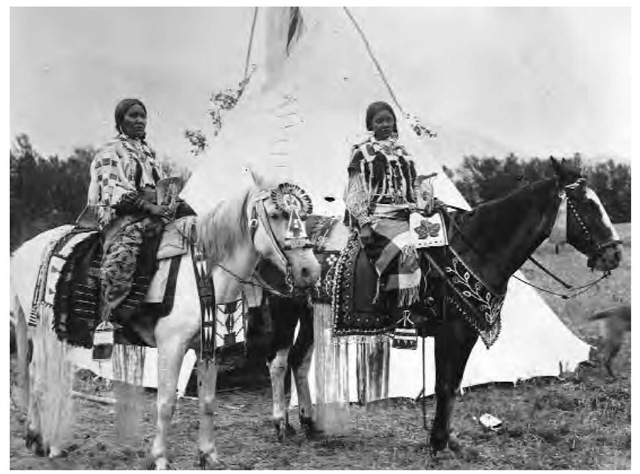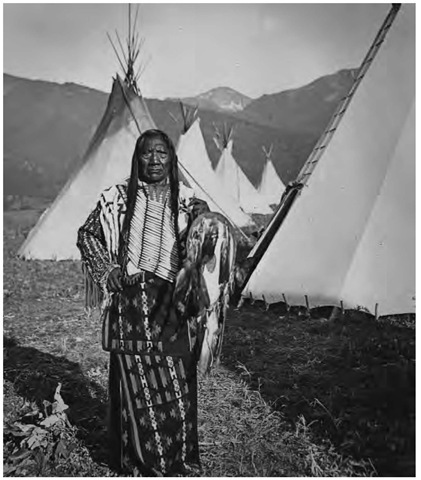Salish, or Flathead, from the fact that they did not, like many neighboring peoples, shape their babies’ foreheads (they left them "flat").
Location Traditionally, the Salish lived in western Montana, around the Rocky and Little Belt Mountains. Today, most live in Flathead, Lake, Missoula, and Sanders Counties, Montana.
Population The precontact population of Salish Indians may have been between 600 and 3,000. In 1990, the reservation Indian population, including Kalispel and Kootenai people, was 5,110, with several hundred Salish Indians also living away from the reservation.
Language The Salish spoke a dialect of Interior Salish.
Historical Information
History All Salish-speaking Indians probably originated in British Columbia. From their base in western Montana, the Salish may have moved farther east onto the Plains before being pushed back around 1600 by the Blackfeet. The Salish continued moving westward, into north-central Idaho, throughout the following two centuries.
Around 1700 they acquired horses and assumed a great deal of the culture of Plains Indians (including buffalo hunting, stronger tribal organization, and raiding). Ongoing wars with the Blackfeet as well as several smallpox epidemics combined in the eighteenth century to reduce their population significantly. They also encountered Christian Iroquois Indians during this time.
Although disease preceded their physical arrival, non-Indians began trading in Salish country shortly after the 1805 visit of the Lewis and Clark expedition. The missionary period began in 1841. In 1855, a major land cession (the Hellgate Treaty) established the Flathead, or Jocko, Reservation, but most Salish Indians avoided confinement until at least 1872, in part owing to their friendliness with the Americans. During these years, other tribes were placed on the reservation, and the buffalo herds diminished rapidly. Charlot, the leader of one Salish band, held out in the Bitterroot Mountains until 1891, when his people finally joined the Flathead Reservation.
Two women on horseback at Flathead Reservation, July 1906. Around 1700 the Salish acquired horses and assumed a great deal of the culture of Plains Indians (including buffalo hunting, stronger tribal organization, and raiding).
The government considered terminating the reservation in the 1950s but was successfully opposed by tribal leaders. In 1960, the tribe won roughly $4.4 million in land claims settlements.
Religion People sought luck from guardian spirits in dreams and visions. Preadolescent spirit quests included fasting and praying. Spirits also conferred songs and objects that became a person’s medicine.
Chief Charlot at Flathead Reservation in the late nineteenth century. Chief Charlot and his people finally joined the Flathead Reservation in 1891.
Shamans’ strong guardians let them cure illness, confer hunting success, and see the future. The many dances and ceremonies of the early historic period included the Sun Dance, Medicine Dance, Hunting Dance, first fruit ceremony, Woman’s Dance, and war dances. Seasonal religious ceremonies were generally related to food or guardian spirits.
Government Various bands were formed of several related families. Each band was led by a chief and an assistant chief, chosen by merit. The chieftainship may have been hereditary in earlier times. Beginning in the late prehistoric period, as tribal cohesiveness increased, the band chiefs formed a tribal council to advise a tribal chief, and later the band chiefs themselves were relegated to the status of minor chiefs or subchiefs. In addition, individuals were selected as needed to lead various activities such as hunting and war.
Customs Rule or law breakers were punished by public whipping and/or ridicule. Premarital sexual relations were frowned on; the woman could be whipped if discovered. Marriage was arranged by families, although some people also eloped. It was formalized by cohabitation as well as a formal ceremony. Polygamy was common. Women were responsible for all domestic tasks.
The dead were buried dressed in skins and robes. A mourning feast followed the funeral; it included the disposal of the dead person’s former possessions. The mourning period could last a year.
Dwellings Winter dwellings were of two types. One was partially excavated, conical mat (cedar bark, hemp) houses on wooden frames; the other was long communal and ceremonial lodges. Brush shelters sufficed during camping and mountain hunting trips. Bark or skin tipis gained popularity after the horse turned the Salish into buffalo hunters.
Diet Beginning in the eighteenth century, buffalo, hunted on the Great Plains, became a key food item. Before this period, however, the Salish ate a number of animals including elk, deer, antelope, and small game. Fish, including trout, salmon, and whitefish, formed an important part of their diet. Plant foods included camas, bitterroot, other bulbs, roots, and berries.
Key Technology Men used hook and line, nets, traps, and weirs to catch fish. Women made birch-bark and woven skin containers as well as coiled cedar baskets. They also made twined grass spoons.
Trade Salish Indians participated in the regional trade, particularly with the Kalispel. They imported Nez Perce baskets and traded in stolen horses from the early eighteenth century on. They became involved in the fur trade in the early nineteenth century.
Notable Arts Women decorated their well-made baskets with geometric designs.
Transportation Pole rafts served as water transportation. The horse arrived after about 1700, and the Salish soon learned to handle this animal expertly.
Dress Most clothes were made from rabbit or deer skins. Men wore breechclouts and shirts, and women wore dresses. Both wore moccasins, caps, robes, leggings, and shell earrings.
War and Weapons The Salish fought few wars before they acquired horses, at which time warfare became common and serious. They often fought the Blackfeet and Crow with the help of the Kalispel and Nez Perce. Capturing an enemy without using weapons was considered a great coup. Dances preceded and followed wars. War captives became slaves.
Contemporary Information
Government/Reservations The Flathead Reservation (1855; Flathead, Kalispel, and Kootenai) is located in Flathead, Lake, Missoula, and Sanders Counties, Montana. It contains 1,244,000 acres. The 1990 Indian population was 5,110. Just under half of the land base is non-Indian owned, and over 80 percent of the reservation population is non-Indian. There is a ten-member tribal council.
Economy Forestry, including sawmills, and ranching are important reservation industries.
Tourist facilities include the KwaTaqNuk resort on Flathead Lake. The tribe receives $10 million on an annual lease for Kerr Dam, on the Lower Flathead River; it will assume the operating license in 2015. Many people work for the tribe, including its tourist resort on Flathead Lake and its facilities at Hot Springs. S&K Electronics provides some jobs. Income is also generated by gravel sales. Unemployment remains quite high (about 50 percent in the late 1980s).
Legal Status The Confederated Salish and Kootenai Tribes is a federally recognized tribal entity. Legal jurisdiction over reservation Indians belongs to the tribes.
Daily Life Despite considerable intermarriage with non-Indians, the tribes attempt to retain their culture and transmit it to the young by means of a cultural heritage project. The reservation is plagued with the serious social ills that often accompany poverty, including substance abuse. Salish Kootenai College and a tribal high school were created around 1977. The tribes hold two large powwows in July and various other activities.


